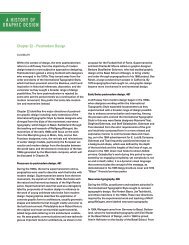Week 11 The German Illustrated Book - A History of Graphic Design
Week 11 The German Illustrated Book - A History of Graphic Design
Week 11 The German Illustrated Book - A History of Graphic Design
Create successful ePaper yourself
Turn your PDF publications into a flip-book with our unique Google optimized e-Paper software.
A HISTORY OF<br />
GRAPHIC DESIGN<br />
guage book. Upon returning to England, he established<br />
the first press on English soil and printed the first book<br />
in England. In France, Philippe Pigouchet introduced<br />
criblé, a technique in which the black areas <strong>of</strong> a woodblock<br />
are punched with white dots, and three <strong>German</strong><br />
printers—Michael Freiburger, Ulrich Gehring, and Martin<br />
Kranz—were brought to the Sorbonne to establish a<br />
press. Spain also received three <strong>German</strong> printers. A<br />
particular masterpiece <strong>of</strong> Spanish typographic design<br />
is Arñao Guillen de Brocar’s Polyglot Bible, which was<br />
designed to accommodate text in five languages and<br />
resulted in five simultaneous typographic presentations.<br />
Typography played a pivotal role in the social, economic,<br />
and religious upheavals that occurred during the<br />
fifteenth and sixteenth centuries. Typography radically<br />
altered education as learning became an increasingly<br />
private, rather than communal, process. Typography led<br />
people toward linear thought, logic, and empirical scientific<br />
inquiry, and fostered individualism.<br />
KEY TERMS (IN ORDER OF APPEARANCE; THE FIRST PAGE NUMBER OF THEIR APPEARANCE IS LISTED)<br />
Incunabula, page 80, (“cradle” or “baby linen”): Its connotations <strong>of</strong> birth and beginnings caused seventeenth-century<br />
writers to adopt it as a name for books printed from Gutenberg’s invention <strong>of</strong> typography until the end <strong>of</strong> the fifteenth<br />
century.<br />
Broadsides, page 80, single-leaf pages printed on one side, which eventually evolved into printed posters, advertisements,<br />
and newspapers.<br />
Incipit, page 81, “here begins,” usually placed at the beginning <strong>of</strong> manuscripts.<br />
Ex libris, page 80, a bookplate pasted into the front <strong>of</strong> a book to identify its owner (Fig. 6-1).<br />
Nuremburg, page 83, Central Europe’s prosperous center <strong>of</strong> commerce and distribution, which also became the center<br />
for printing by the end <strong>of</strong> the fifteenth century.<br />
Exemplars, page 84, handmade model layouts and manuscript texts used as guides for the woodcut illustrations, typesetting,<br />
page design, and makeup <strong>of</strong> books (Figs. 6-14 and 6-15).<br />
Broadsheet, page 90, single-leaf pages printed on both sides, which eventually evolved into printed posters, advertisements,<br />
and newspapers.<br />
Criblé, page 95, a technique in which the black areas <strong>of</strong> a woodblock are punched with white dots, giving the page a<br />
lively tonality (Fig. 6-34).<br />
Polyglot, page 97, written in several languages (Fig. 6-36).<br />
KEY PEOPLE (IN ORDER OF APPEARANCE; THE FIRST PAGE NUMBER OF THEIR APPEARANCE IS LISTED)<br />
Martin Luther (c. 1483–1546), page 81, After he posted his Ninety-five <strong>The</strong>ses on the door <strong>of</strong> Castle Church in Wittenberg,<br />
Saxony on October 31, 1517, his friends passed copies on to printers. By December, his proclamation had spread<br />
throughout central Europe and within a few months, thousands <strong>of</strong> people all over Europe knew his views.<br />
Albrecht Pfister, page 81, a Bamberg printer who began to illustrate his books with woodblock prints. He used five<br />
woodblocks and the types from Gutenberg’s thirty-six-line Bible to print his first edition <strong>of</strong> Johannes von Tepl’s Der<br />
Ackerman aus Böhmen (Death and the Plowman) (Fig. 6-2).<br />
Günther Zainer, page 81, a scribe and illuminator who had learned printing in Strasbourg and who established a press<br />
in Augsburg. An agreement allowed Zainer to use woodblock illustrations as long as he commissioned them from<br />
members <strong>of</strong> the woodcutter’s guild. He introduced a greater tonal range to page design by using woodcuts with textured<br />
areas and some solid blacks (Figs. 6-3 and 6-4).
















